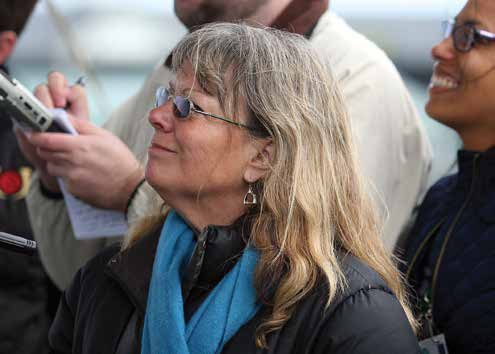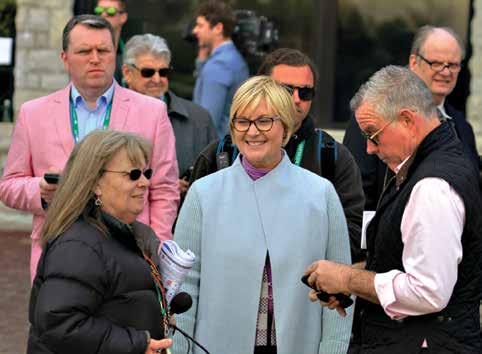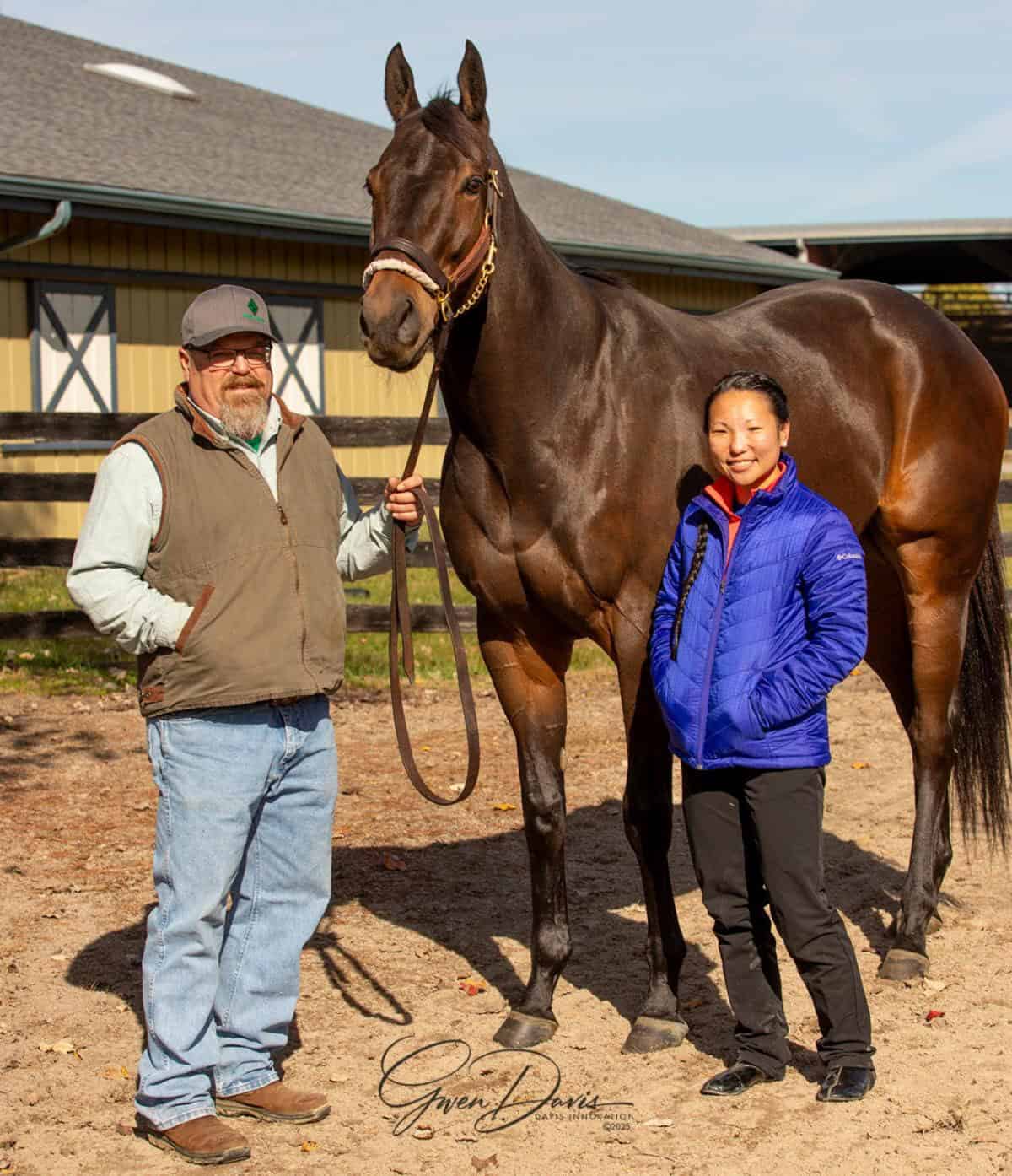The Backbone of the Stable: Award-winning Turf Writer, Publicist Jennie Rees Continues to Advocate for Horses and Their Caregivers
 from the Spring 2025 issue of The Horsemen’s Journal
from the Spring 2025 issue of The Horsemen’s Journal
By Hannah Hamelback
Photos by John Engelhardt
Precarious Man fit the popular Thoroughbred look: dark bay, with a black mane and tail, a chiseled head on a long neck and a lean body with deep, muscular shoulders. On the morning of February 3, 1988, Precarious Man was on a 0-for-19 losing streak. He was a come-from-behind sprinter, usually an underdog who needed a lot of hope to make an impact on the track. Race after race, there was a sliver of hope that just maybe he would pull ahead to be first across the finish line. But more often than not, he’d finish a distant fourth or fifth. Despite trainers trying different tactics, like running him at longer distances, he never quite made the leap.
Pat Dupuy had privately bought Precarious Man four months and five races before that February morning and sent the horse to his father, trainer John Dupuy. Precarious Man was stabled in New Orleans and raced at Fair Grounds and Jefferson Downs, a small and long since shuttered track in Kenner, Louisiana. Pat also had recently become engaged to an up-and-coming horse racing journalist, Jennie Rees. Rees was still learning the ins and outs of the racing industry, but after she and Pat started dating, she gained a new perspective on the industry that standard journalistic reporting could not provide.
Rees had traveled to New Orleans to support Dupuy and Precarious Man in one of the cheapest claiming races on the card that warm February afternoon at Fair Grounds. It was an ordinary race day, and although the sliver of hope still shined, Precarious Man’s losing skid lingered in everyone’s mind. As he and his opponents reached the starting gate, Rees longed for the 5-1 odds to prevail.
The bell echoed throughout the track, and the horses were off.

JENNIE REES (LEFT), HERE AT KEENELAND RACE COURSE WITH AWARD-WINNING BROADCASTERS CATON BREDAR AND STEVE BYK, WEARS MANY HATS AS A MEMBER OF THE MEDIA AND AS A PUBLICIST.
Rees watched from the stands with growing anticipation. Precarious Man started the race like normal, his pace consistent with his previous 19 losses. Just as his supporters began to accept another defeat, he seemed to launch into overdrive. Precarious Man rounded the corner for the final stretch, and in the blink of an eye, the gap between him and the leaders started to close.
Rees watched as if time slowed down.
“Could this really be the day?” she thought.
Precarious Man finally pulled ahead to win, providing a moment of pure joy for Rees. After so many near-wins, the underdog did, in fact, prevail. The track held a small trophy presentation afterward, nothing fancy, just a humble token of the victory. But to Rees, that trophy was worth more than any other. It was an unexpected triumph, one she cherishes to this day, and a moment she credits as a top-three memory.
“How could you not be hooked after something like that?” she said, years later.
Rees grew up in Lexington, Kentucky, otherwise known as the “Horse Capital of the World.” She never took an interest in racing, even though it surrounded her. Her passion was rooted in sports, her talent distinguished in writing, and her dream was to report on college athletics for a major newspaper in the Big Ten or SEC country. The closest encounter Rees had to racing as a child was a spontaneous trip to Keeneland Race Course on spring break with her mother and sister to watch the horses train. The transformative moment came as a Tates Creek High School senior when her best friend, Mona Rozovich, with access to a car, said, “Let’s go to Keeneland for the races.”
The spring meeting was bustling with excitement, yet Rees entered a foreign world. The track was alive with color and sound—the manicured grass a deep emerald, the dirt track freshly combed by John Deere tractors and the faint murmur of the crowd building into a roar throughout the race. Rees watched in awe as she felt the pounding hooves reverberating in her chest.

THE LATE AWARD WINNING TURF WRITER BILLY REED INTRODUCES JENNIE REES DURING AN EVENT TO RECOGNIZE HER PLACE IN THE NATIONAL MUSEUM OF RACING’S JOE HIRSCH MEDIA ROLL OF HONOR.
As the day came to a close and the horses returned to their barns, the moment lingered before fading; Rees didn’t know the names of the horses, who the jockeys, trainers or owners were or what the racing odds even meant. She simply knew this would be a core memory. However brief, that glimpse into the world of Thoroughbred racing foreshadowed her future.
Rees pursued her dream of sports journalism at Indiana University. After graduation, she secured a post-grad internship in the sports department of the Cincinnati Enquirer. Her first racing story proved memorable, albeit for an embarrassing reason. She was assigned to cover a stakes race at Cincinnati’s River Downs on a steamy July 4th. Not even knowing what a stakes race was, she relied on the late Pat Lang, then the track’s publicity director, who helpfully directed Rees to the person she needed to interview. That trainer talked about the winner having been a “rogue horse” and mentioned they’d almost resorted to “cutting” him. Rees froze, alarmed, and thought they meant putting the horse down. Once she became a full-time Turf writer, Rees soon learned that cutting a horse meant castration. Several years later, in the middle of the night, the memory of her first race story flashed back for some reason.
“I thought, ‘What did I write?’ I’m pretty sure it was that the horse came close to being killed,” she said.
She laughed at herself, shaking her head.
“I’ve come a long way since then,” she said.
After two years in Rochester, New York, Rees returned to Kentucky in 1981 to work in the sports department of the Louisville Courier-Journal, still intent on being a major college beat writer. Two years later, she landed the part-time horse racing beat in addition to covering Division II basketball and tennis while simultaneously working the sports copy desk. When the afternoon Louisville Times merged with the Courier-Journal in 1986, Rees became the first full-time Turf writer in the long history of the Louisville newspapers. By then, she was hooked, and the thought of covering any other sport evaporated.
Earning Their Trust
Racing is a vital industry that not only sustains the livelihoods of many but also plays a significant role in the broader entertainment world. Any sector of the entertainment industry—whether sports, film or music—is subject to both criticism and regulation. In the case of horse racing, much of the criticism often comes from those outside the industry. The lack of understanding of the complexities of the sport and the dedication required to be a horseman or horsewoman can lead to misinformed judgments.
Horse racing is often referred to as “the Sport of Kings,” given the sport’s historical association with royalty. To an outsider, racing might seem like a sport for the rich, with millions of dollars exchanged at every race. But racing doesn’t survive on wealth alone. It thrives because of the horsemen and women—the trainers, barn staff, veterinarians, jockeys, farriers and others who dedicate their lives to the horses’ well-being and keep the industry moving. These people aren’t motivated by money or politics; they are motivated by their passion for the horse. For every racehorse, there are at least 26 employees connected to the security of the horse.
Rees has worked tirelessly to give a voice to those unsung heroes, publishing their stories across platforms to educate and inform the public about the reality of being a horseman or horsewoman.
However, it wasn’t until she met her husband, now-retired trainer Pat Dupuy, in 1985 that she began to truly see the sport from an insider’s vantage point.
Rees was at Churchill Downs writing a story for the Courier-Journal when a groom approached her with a compliment on her ballcap for the Red Mile, Lexington’s Standardbred track. Rees casually offered to pick up a few the next time she was in Lexington and bring them back for anyone who wanted one.
A few weeks later, Rees returned with Red Mile ballcaps in hand. She quickly sold most of them but still had some left. After feeling like an auctioneer, Rees heard someone call out from the back of the barn, “What about Dupuy?” A shy assistant trainer named Pat Dupuy (pronounced by his family as “DOO-pree” but known to everyone on the backstretch as “DOO-pee”) stepped forward and shrugged. “Yeah, sure. I’ll take one.” On a whim, Rees decided not to charge him. Instead, she handed him the cap with a grin and said, “You can buy me a beer at Bernie’s after this.”

JENNIE REES INTERVIEWS FORMER MAJOR LEAGUE BASEBALL OUTFIELDER JAYSON WERTH BEFORE LAST YEAR’S KENTUCKY DERBY AS EVENTUAL BELMONT STAKES WINNER DORNOCH RELAXES IN HIS STALL AT CHURCHILL DOWNS.
That evening, Rees and Dupuy ended up at Bernie’s, the local bar where horsemen gathered after long days at the track. One beer turned into two, then three, and by the end of the night, a spark had ignited. From that night on, Rees and Dupuy grew inseparable.
Rees soon found herself working from an unlikely office: the tack room. While meeting deadlines and chasing down stories, she also took on the role of Dupuy’s barn hand. As her involvement grew, she became a licensed hotwalker in Kentucky, Pennsylvania, Ohio, Florida, Illinois, West Virginia and Indiana.
Spending long hours on the backside of the track with Dupuy gave her access to a side of the industry few journalists experience. Her early mornings and late nights in the barn and on the track brought valuable connections, earning her a reputation among trainers, jockeys and barn staff as someone they could trust. In time, this dual role as journalist and track worker became one of her greatest assets, solidifying her place within the racing community.
Fighting for the Little Guys
Rees worked her way from knowing nothing about the racing industry to winning four individual Eclipse Awards, racing’s most prestigious journalism honor, and a fifth for leading a Courier-Journal multimedia project. She was voted the Kentucky Sportswriter of the Year twice by the National Sportscasters and Sportswriters Association. In 2014, she was named to the National Museum of Racing and Hall of Fame’s Joe Hirsch Media Roll of Honor.
By then, Rees knew she wanted to plunge full time into horse racing and jumped at the opportunity to take a corporate buyout from the Courier-Journal in late 2015. Almost seamlessly, she became a communications and advocacy specialist in the horse industry, handling communications for the Kentucky Horsemen’s Benevolent and Protective Association as well as serving as the media consultant for the National HBPA. She also is Kentucky Downs’ publicity director.
When the Kentucky HBPA worked to protect pari-mutuel wagering through historical horse racing machines in 2021, the former executive director, Marty Maline, called upon Rees to use her legislative contacts and relationships to help tell the stories of horsemen and horsewomen in order to promote the livelihood side of the industry.
Rees joined the movement and noticed that the racing industry was largely being portrayed through pictures of beautiful, pristine paddocks at farms with mares and their foals. Rees believed this was the wrong approach.
“This is why [legislators] think we are the Sport of Kings, because they used a piece of property owned by someone very wealthy,” she said. “That’s not what they want to see. We started publishing pictures of people interacting with the horses at the racetrack. … People on the backside doing their job.”
In one Kentucky HBPA promotion, Rees published a video that shared the story of Gary Churchman, a blacksmith who has been a racetrack farrier for more than 40 years. He talked about historical horse racing’s impact on the Kentucky racing industry, saying that although he might not be a “rich man,” he was able to put his two children through college by shoeing horses.
Rees’ campaign to debunk the Sport of Kings stereotype and to portray horsemen and horsewomen as ordinary people who are simply trying to make a living succeeded. Damon Thayer, the former Kentucky Senate majority floor leader, credited the Kentucky HBPA as being one of the biggest difference makers in saving the state’s ability to wager on historical horse racing.
Kentucky Governor Andy Beshear subsequently signed legislation aimed at securing the legality of betting on historical racing machines, which, overall, protects the state’s Thoroughbred racing industry. As a journalist and media consultant, Rees has spent her career writing articles and press releases, gathering signatures for surveys, creating video interviews and telling the stories of horsemen and horsewomen. But above all her titles and accolades, she is a horsewoman who fights for the little guys.
“You cannot build a race card without the little guys,” she said. “[Regulation] is being stacked against them because so many of the changes are made to accommodate the big guys. But you still have these little guys who love the horse. … You can’t run them off. They are the backbone.”
Precarious Man’s win back in February 1988 wasn’t just a fleeting moment of victory on the track; it was a testament to the power of perseverance, hope and resilience. Much like that underdog Thoroughbred, Rees carved her own path in an industry that often seemed insurmountable. She began her career with minimal knowledge of racing but transformed herself into a trusted voice for the unsung heroes of the sport.
From the backside barns to the halls of the state capitol, Rees has fought tirelessly to amplify the voices of those who, like Precarious Man, might otherwise be overlooked. Just as the underdog sprinter finally crossed the finish line in front, Rees’ career stands as a testament to what can be achieved with unwavering passion and determination. Her journey of becoming a horsewoman proves that the heart of horse racing isn’t just in the glory of the finish line but in the grit, dedication and love for the sport shared by all who make it possible—the backbones.
Hannah Hamelback is a senior at Western Kentucky University, graduating in May 2025 with a major in broadcasting, a minor in journalism and a certificate in strategic communication. A native of Paris, Kentucky, Hamelback grew up in barns and formed bonds with horses of all backgrounds, whether a Kentucky Derby-winning stallion like Giacomo or a retired barrel racing pony named Pete. She has observed the Thoroughbred industry through a unique and personal point of view, and her experiences have fueled a deep appreciation for the often-overlooked stories within the horse racing world. With aspirations to blend her love of horse racing and her passion for storytelling, Hannah crafted “The Backbone of the Stable” as a heartfelt homage to the industry’s unsung heroes, showcasing her distinct perspective and capturing the essence of a world she holds close to her heart.





